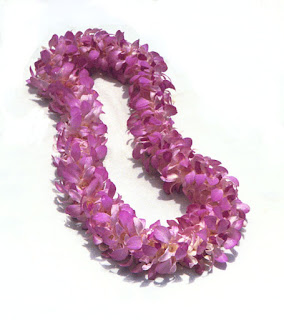by Jill Steele
The History of the Hawaiian Lei
The lei, the ultimate symbol of love and Aloha in
Hawaii, has been an important part of Hawaiian culture in both ancient and
present times.
The ancient Hawaiians made their lei of hair,
bone, ivory, seeds, teeth, feathers, and shells as well as adorning and
beautifying themselves with the colorful flower and braided leaf leis most
commonly known today. They made lei for each
other and for their Gods as signs of love and affection. The flowers they used
had both religious and mythological meanings.
Leis made of sweet smelling fruit of the hala tree
were associated with both love and desire, as well as marking a transition, or
passing. Even today, many Hawaiians are superstitious and don't wear hala-fruit
leis. Red Lehua blossoms were and are
still considered the flower of Pele, the volcano goddess and her sister Hiiaka.
Lehua blossoms are thrown into the volcanoes today as offerings to Pele.
The Kukui nut lei was worn
only by the Alii (royalty). The Kukui tree, also known as the candlenut
tree provided light in the form of torches made from the the kokui nuts. The
nuts were also used for their oil and in religious practices.
Fragrant Maile leaf leis, worn freely by ancient
Hawaiians of all classes, were associated with worshipping the gods of hula.
Plumeria , one of today's most commonly used lei
flowers, actually originated in Mexico and Central America and was first
cultivated in Hawaii around 1860. Dendrobium orchids, another of
the flower popular lei flower today, because of both its beauty
and heartiness were first brought to Hawaii from the Phillipines in
1896.
Beginning in the late 1800’s when steamships
brought visitors to the islands, the beautiful Hawaiian wahine (women) swam out
to the ships to welcome the visitors with colorful,
fragrant leis. People began to
create legends about the lei. Some said the lei was lucky. The most popular
legend was that upon leaving Hawaii to return home to the mainland, if you
tossed your lei overboard and it floated toward the beach, you would someday
return to the Hawaiian islands. In the 1800's when a steamship would leave the
island, hundreds of leis thrown by tourists would be seen floating on the
surface of the ocean.
Jack London wrote a book of short stories called
"Stories of Hawaii" chronicling life in 1800's Hawaii. In a story about
Alexander Liholiho, who later became King Kamehameho IV, he wrote about the
festive wearing of leis by the Hawaiian paniolo (cowboys) . "And they came,
riding up from Kawaihae, where they landed from the Royal Yacht, the whole
glorious calvacade of them, two by two, flower-garlanded, young
and happy, on Parker Ranch horses, thirty of them in the party, a hundred Parker
Ranch cowboys and as as many of their retainers-a royal progress.
Today lei are given to mark important events. They
are given for births, birthdays, graduations, weddings, religious ceremonies,
engagements and are even given and worn for funerals. When famous professional surfer Andy Irons died this year, thousands of
his friends and fellow surfers paddled out in the ocean on surfboards with leis
and flower offerings to honor him.
In Hawaii, the giving of graduation lei is a
longstanding tradition. Graduates of of all ages are given many leis by
friends and relatives. It is common to see graduates wearing leis piled on top
of each other all the way up their necks! Leis are fun to wear and make the
graduation ceremony even more beautiful and colorful. The Aloha spirit of lei
giving for graduation has now spread to the mainland too. Each year thousands
of leis are shipped to mainland high school and college graduations.
There is even a special day in Hawaii known as Lei
Day. Lei day is May 1, the same as May Day. Everyone from schoolchildren to
executives wear leis on this day. It was first observed in 1929, the idea of
writer Don Blanding, who wanted "a day of general rejoicing over the fact that
one lived in a Paradise. Let it be a day for remembering old friends, renewing
neglected contacts, with the slogan Aloha, allowing that flexible word to mean
friendliness on that day." In Hawaii lei
making begins as early as pre-school where large mounds of fragrant flowers are
placed in the center of the tables to be strung into colorful leis to be worn
for the May Day/Lei Day festival.
One little known fact by mainlanders is the
word lei is both singular and plural. There is no letter "s" in the Hawaiian
language. The "s" has been added and is commonly used so as not to confuse
those not local to Hawaii.
By tradition, a lei must be presented by placing the
lei around the recipient's neck and followed by a kiss on the cheek. After
receiving a lei, the recipient should never remove it in the presence of the
giver. When it is no longer fresh, a lei should be given back to the earth by
removing the flowers and disposing of the string. Never put a lei in the
trash!
Sources:
http://www.natural-elements-online.com/history-of-kukui-tree.asp
Hula Moons by Don Blanding
Coffeetimes.com
Hawaiiforvisitors.com
Hawaiian Lei Making Step by Step Guide by Laurie
Shimizu Ide
http://www.plumerias.com/weblog/history_and_research/
http://davesgarden.com/guides/articles/view/160/




